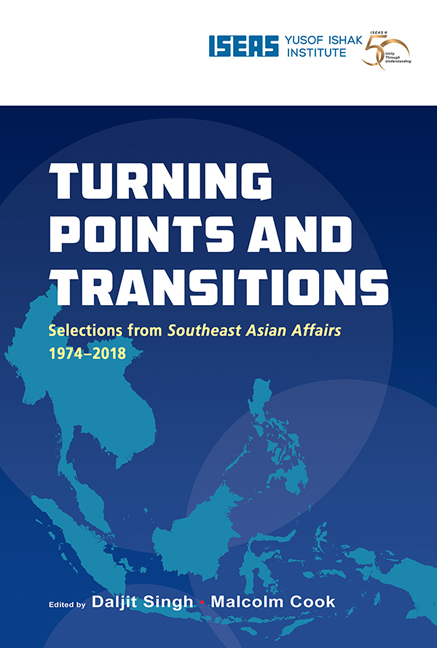Book contents
- Frontmatter
- Contents
- Message from the Director
- Foreword
- Foreword
- Introduction
- THE REGION
- BRUNEI
- CAMBODIA
- INDONESIA
- LAOS
- MALAYSIA
- MYANMAR
- THE PHILIPPINES
- An Overview of the Philippines (1974)
- Unfinished Revolution: The Philippines in 1986 (1987)
- Terrorism: Evolving Regional Alliances and State Failure in Mindanao (2006)
- SINGAPORE
- THAILAND
- VIETNAM
Unfinished Revolution: The Philippines in 1986 (1987)
from THE PHILIPPINES
Published online by Cambridge University Press: 29 May 2019
- Frontmatter
- Contents
- Message from the Director
- Foreword
- Foreword
- Introduction
- THE REGION
- BRUNEI
- CAMBODIA
- INDONESIA
- LAOS
- MALAYSIA
- MYANMAR
- THE PHILIPPINES
- An Overview of the Philippines (1974)
- Unfinished Revolution: The Philippines in 1986 (1987)
- Terrorism: Evolving Regional Alliances and State Failure in Mindanao (2006)
- SINGAPORE
- THAILAND
- VIETNAM
Summary
Introduction
The unfolding of the affairs of nations rarely corresponds neatly with the beginning and end of the calendar year, and the experience of the Philippines in 1986 was no exception. The dramatic events of 1986, the high point of which was the toppling of the Marcos regime by a non-violent revolution in February, were inextricably rooted in the political and economic crises that had wracked the country since the assassination of Benigno “Ninoy” Aquino, Jr. in August 1983. Likewise, many of the daunting problems and challenges facing the Philippines in the post-Marcos era will not begin to be resolved until well into 1987, if at all.
Despite this seamless flow of events, the changes that occurred in the relatively short span of twelve months created a dramatically new political environment in the Philippines by the end of 1986. At the beginning of the year, for example, Ferdinand Marcos, weakening but still powerful, was marshalling the intimidating powers of his presidential office and political machine to assure his re-election in the face of the strongest political challenge ever to his twenty-year rule. At year end, Marcos was in exile in Hawaii and President Corazon (“Cory”) Aquino sought to fend off challenges from both the left and the right as she struggled to consolidate her still shaky political position and define and pursue the policy agenda of her coalition government.
In January, the leadership of the Philippine Armed Forces appeared to be loyal to President Marcos, despite the growing prominence of the Reform the Armed Forces Movement (RAM). By December, however, Defence Minister Juan Ponce Enrile and his RAM followers had gone from being heroes of the February revolution to being outcasts as a result of their challenge to the Aquino government. Meanwhile, General Fidel Ramos, the other “Hero of EDSA (Epifania de los Santos Avenue)”, opted to support the Aquino government, and by doing so, strengthened his position as a key figure in the Aquino administration.
At the start of the year the communist insurgency continued to grow, and perversely, the insurgency issue was used effectively by Marcos to criticize the Aquino candidacy and justify his continued rule. By December the communists had recovered from their politically damaging boycott of the February election and were using a fragile sixty-day cease-fire to mount an effective public relations campaign.
- Type
- Chapter
- Information
- Turning Points and TransitionsSelections from Southeast Asian Affairs 1974-2018, pp. 548 - 571Publisher: ISEAS–Yusof Ishak InstitutePrint publication year: 2018



